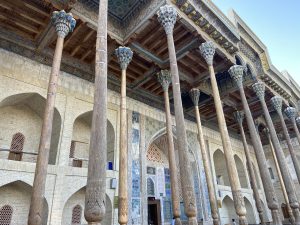More than two months have passed since mass protests erupted in Uzbekistan’s northwestern region of Karakalpakstan over proposed constitutional amendments that aimed to strip the republic of its autonomy. The protests led to serious violence by security forces, including at least 21 killed, 243 injured, and 516 detained, according to official sources. By far the worst crisis of President Shavkat Mirziyoyev’s tenure, at the time of writing there are serious concerns that among the individuals detained for taking part in the protests, several have been subjected torture, denied access to independent counsel, or held incommunicado, such as two local journalists – Lalagul Kallykhanova and Dauletmurat Tazhimuratov – who publicly decried Tashkent’s attempts to downgrade the region’s autonomous status and whose peaceful exercise of their rights was well-documented.
Mirziyoyev has taken some appropriate measures such as withdrawing the proposed amendments, acknowledging possible abuses by law enforcement, and authorizing a parliamentary commission to investigate the events. But other moves have been reminiscent of the Uzbek government’s crackdown following the Andijan massacre of 2005, such as the decision to forge ahead with stifling restrictions on the activities of non-governmental organizations (NGOs). A June 2022 decree mandates that NGOs partner with a government body in order to implement activities – a provision that contradicts Uzbekistan’s law on NGOs and defeats the notion of NGOs as non-governmental. Moreover, there has been persistent rhetoric, from Mirziyoyev on down, blaming what happened in Karakalpakstan on “forces from abroad” rather than endorsing a sober discussion about the multiple factors that drove thousands to take part in the largest protests in Uzbekistan’s recent history.
For many, mass protests in Karakalpakstan and discussions about its autonomy were the first they had ever heard of the Karakalpaks, a Turkic ethnic group numbering more than 400,000 who possess a distinct language (closer to Kazakh than to Uzbek), nomadic traditions, and their own national symbols. More broadly, it was also perhaps the first time many had truly considered Uzbekistan’s diverse and multiethnic character.
The violence and abuses that shook Karakalpakstan brought into sharp relief the reality that in Uzbekistan, as in almost every modern state, ethnic minority issues, actual or perceived ethnic discrimination, language rights, and the need for minority political representation not only drive protest, but are fundamental to overall governance and the protection of all Uzbekistanis’ human rights. Indeed, the question of how Uzbek authorities have, at key points in history, failed to protect minorities are rarely, if ever, discussed, and should be examined more closely. A closer look reveals that issues of ethnic identity have often been major flashpoints in Uzbekistan’s development, especially when they have intersected with socioeconomic and political concerns.
































